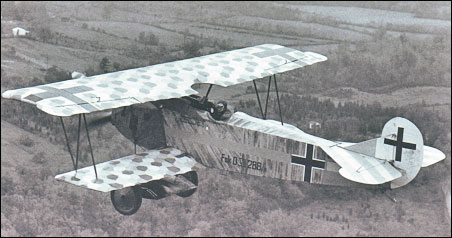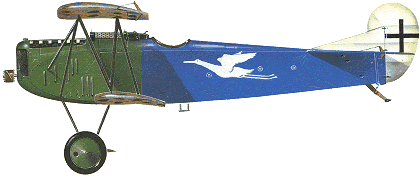 |
Fokker D.VII1917 |  |
| FIGHTER | Virtual Aircraft Museum / Germany / Fokker |
 |
Ordered on 20 September 1917 as a parallel development to the rotary-engined V 9 (from which was to be derived the D VI), the V 11, powered by a 160hp Mercedes D III six-cylinder water-cooled engine, was the progenitor of the D VII, the most famous of all German World War I fighters. Of mixed construction like preceding Fokker fighters, the V11 flew in December 1917, but revealed some directional instability and other shortcomings. These were rectified by lengthening the fuselage, reducing the wing gap and stagger, etc, and the V 11 competed at Adlershof, together with the essentially similar V18, in the January 1918 D-type contest. Pronounced winning contenders by the Idflieg, these prototypes provided the basis for a fighter to which the designation D VII was assigned, contracts being placed with Fokker at Schwerin and the Albatros factories at Johannisthal and Schneidemuhl (OAW). Other prototypes comprised V 21, the 200hp Austro-Daimler-engined V 22 - which was to be evaluated at Aspern in July 1918 - and the 185hp BMW Illa-engined V 24. This last served as the prototype of the similarlypowered D VIIF. Armed with two 7.92mm LMG 08/15 guns, the D Ill-powered D VII began to reach the Front in April 1918, followed closely by the BMW Illa-powered D VIIF, and licence production of the D VII with the Austro-Daimler engine was undertaken by MAG (Magyar Altalanos Gepgyar) in Hungary. In the event, MAG completed only 12 D VIIs, and these postwar. Fokker produced 877 series D VIIs (of which six were supplied to MAG as pattern aircraft together with the V 22), and 923 and 826 were built respectively by the Johannisthal and Schneidemuhl facilities of Albatros. Ninety-eight D VIIs were smuggled from Germany to the Netherlands after the Armistice, of which 22 went to the LVA (Luchtvaartafdeling), 20 to the MLD {Marine Luchtvaartdienst), six to the KNIL (Koninklijk Nederlands Indisch Leger) and the remaining 50 were sold to the Soviet Union. Eight D VIIs and two D VIIFs were acquired from the Allied Control Commission by the Swiss Fliegertruppe- one of these later being fitted with an Hispano-Suiza 8Fb engine as the D VIIS - which obtained a further six overhauled D VIIs in 1925 from the Swiss Alfred Comte concern, which went on to build eight D VIIs during 1928-29. A total of 142 D VIIs was shipped to the USA in 1919 for evaluation and use by the US Army's Air Service, at least a dozen of these being used at McCook Field for experimental work with various engines, including the 230 and 290hp Liberty, 200hp Hall-Scott L-6 and 375hp Packard 1A-1237. Several more D VIIs were purchased in 1920 for the Air Service from Fokker, and other countries to adopt the D VII post-World War I included Belgium, which received 75 from March 1919. Of these, 35 were-delivered to the Army's Aviation Militate, remaining in service until 1931.

|  COMPANY PROFILE | ||||||||||||||||||||||||||||||||||||||
 |

|
